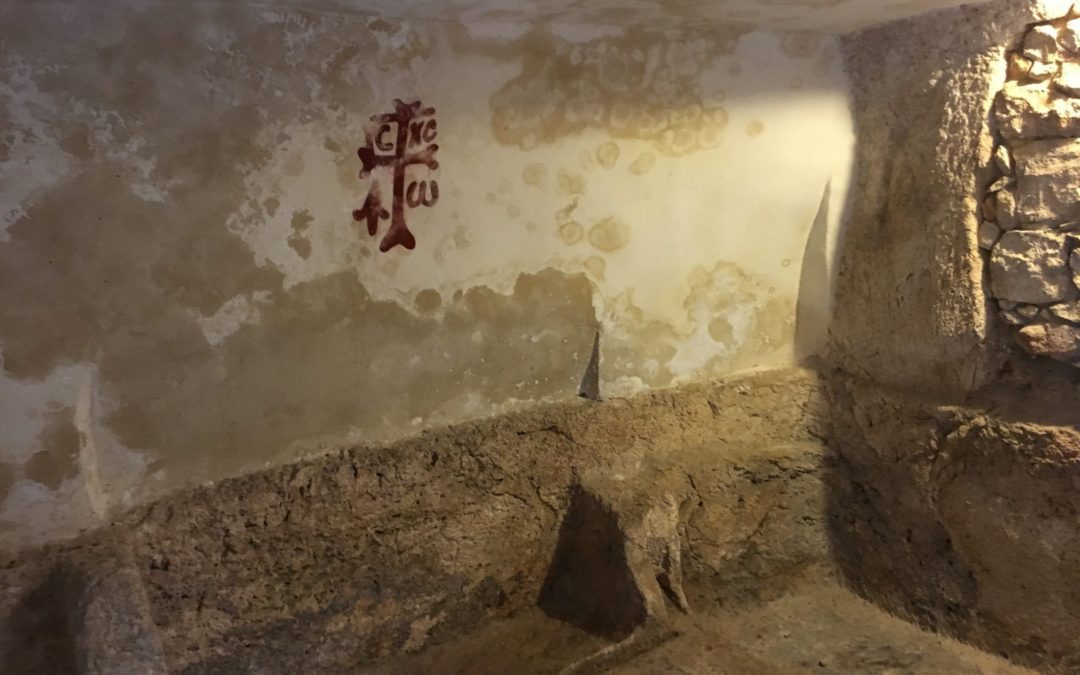Our tour group gathered beneath a canopy at the Garden Tomb in Jerusalem, listening to our guide on a beautiful, shirt-sleeve day. To one side, we could hear the singing of another church group gathered near the tomb, and to the other side was the cacophony of the city—traffic horns and the constant rumble of construction machinery.
Although we often think of Golgotha, where Jesus was crucified, as being isolated from the bustle of the city, the Romans had a way of crucifying people along busy roads. That way, more people would see what happens when you go against the Empire. So, the noise of Jerusalem surrounding the Garden Tomb was actually more in line with the way it might have been.
As our guide continued to talk, a nearby loudspeaker, mounted on a pole, began blasting an Islamic chant. Rather than shout over the chant, our guide stopped to lead us in singing, “Amazing Grace.â€
This clash of sound was a symbol to me of the tense and sometimes violent convergence of three major religions—Judaism, Christianity, and Islam—in one Holy City. It also reminded me that when Jesus walked the streets of Jerusalem, He too found Himself in the middle of a discordant, tense community where the Jewish nation struggled to survive in Rome’s pagan world of many gods.
Some things never change.
Most experts do not believe this Garden Tomb was the actual burial place for Jesus, but it certainly looks like the tomb would’ve appeared over 2,000 years ago. The nearby hill even has what looks like the eye sockets of a giant skull, which is what led this site to be identified in the 1800s as the possible site of the crucifixion. Golgotha means “place of a skull.â€
Our guide at the Garden Tomb was quick to emphasize that there were probably many such tombs in the area, so the chance that this was Jesus’s gravesite is not likely. The entrance to the Garden Tomb was cut into the side of the hill, and after I ducked to enter the cramped space, I found myself six feet away from a stone slab where the body would’ve lain.

The traditional burial site of Jesus is inside the Aedicule (the silhouette) in the Church of the Holy Sepulchre.
The Garden Tomb may “feel†like the authentic location of Jesus’s tomb, but the traditional site is in the Church of the Holy Sepulchre. Inside this church is an inner sanctuary, called the Aedicule, where you can find the tomb believed to be where Jesus was buried.
We opted not to stand in the two-hour line to enter the Aedicule, but we did file past several other key locations within the sprawling, crowded, dimly lit church. We saw the Altar of the Crucifixion, where you could see what many believe is the Rock of Calvary where the cross was placed, now visible through glass. Directly beneath the Rock of Calvary is the Chapel of Adam, where tradition says the skull of Adam was buried. In fact, one story says Jesus’s blood seeped down through the rocks and filled Adam’s skull.
The Bible says nothing about this, so who knows.
What we do know is that when Mary Magdalene went to the tomb on that earth-shattering morning, she found the tomb empty, and she began weeping.
Two angels were there, and they asked her, “Woman, why are you crying?â€
“They have taken my Lord away,†she said, “and I don’t know where they have put him.â€
Moments later, Mary ran into a person she thought was a gardener, but when He spoke her name, “Mary,†her eyes were opened, and she realized who it was. “Rabboni!†she exclaimed, and when she later saw the disciples, she announced, “I have seen the Lord!â€
In this passage from John 20, Mary Magdalene was anxious to know where Jesus’s body had been taken, and today we too would love it if we knew for certain where Jesus’s body had been buried before the Resurrection. We are left with two different sites—the Garden Tomb and the Church of the Holy Sepulchre—and we don’t know for certain if either one of them is the actual tomb. But, as our guide at the Garden Tomb said, the important thing is the Person, not the place.
The important thing is that Jesus is with us today, every bit as much as He was with Mary Magdalene on that first Easter morning. I was thrilled to be close to the spot where He might’ve been buried, but you don’t have to travel to Jerusalem to get the same thrill. Even when we’re in our backyard in Detroit or San Diego, He’s calling out our name and waiting for us to answer, “Rabboni!â€
He’s waiting for us to tell everyone we have seen the risen Lord.Â
–Doug Peterson

